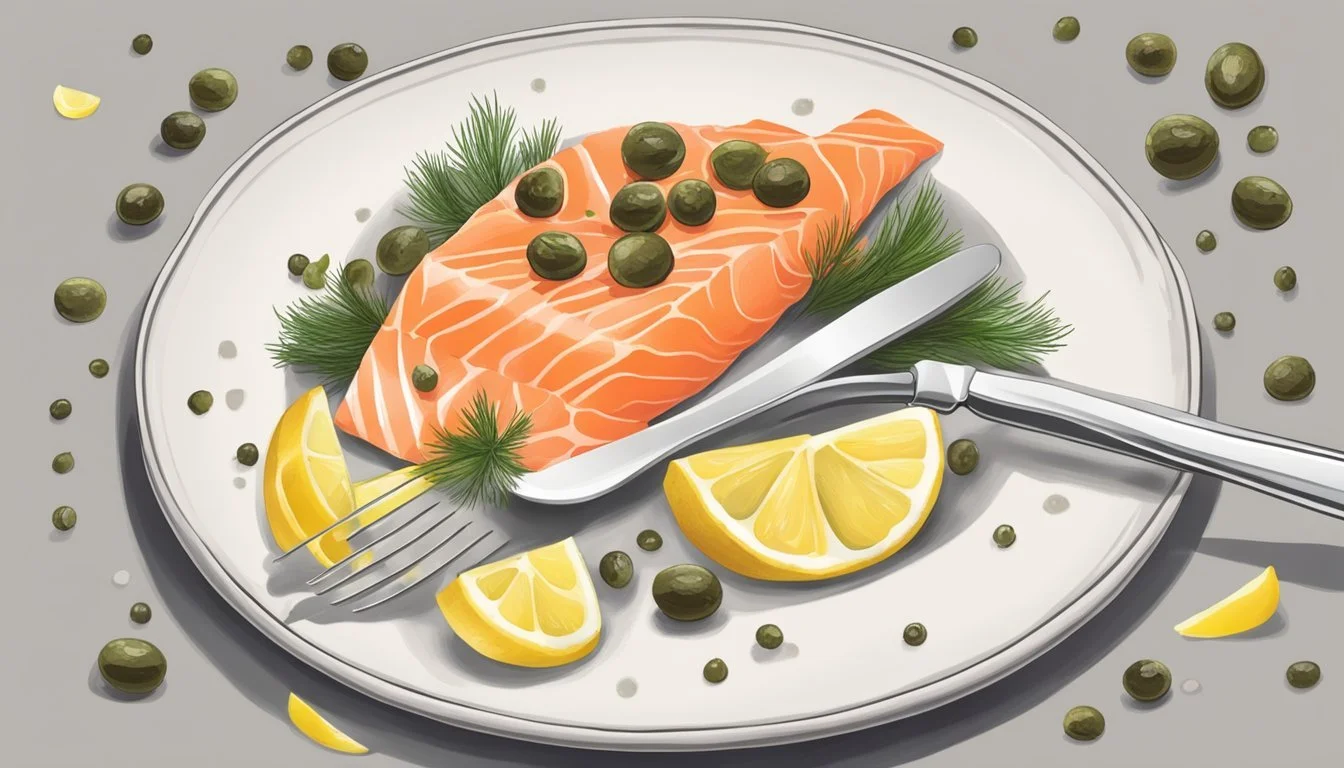How Do You Eat Smoked Salmon?
Tips for Enjoying This Delicacy
Smoked salmon, (What wine goes well with salmon?) a delicacy loved for its rich flavor and silky texture, is a versatile ingredient that can be enjoyed in myriad ways. It is commonly prepared by curing salmon with salt, sugar, and various seasonings before being subjected to the smoke of smoldering wood chips, which imparts a distinctive smoky flavor. Whether served as a sophisticated appetizer, a brunch (What wine goes well with brunch?) staple, or a dinner entree, smoked salmon's appeal lies in its ability to elevate the simplest of dishes.
The consumption of smoked salmon is not just a culinary indulgence but also brings several health benefits. It's a rich source of omega-3 fatty acids, proteins, and other essential nutrients, contributing to heart health and overall well-being. Due to its nutrient profile, incorporating smoked salmon into one's diet can be part of a balanced approach to eating.
Individuals can relish smoked salmon in simple preparations, such as on top of a bagel with cream cheese or as a twist in a traditional egg scramble. It can also be creatively integrated into myriad recipes, from being tossed into a fresh salad, folded into an omelet, or layered onto canapés, offering a splash of elegance to various meals. The adaptability of smoked salmon makes it a staple in kitchens for those seeking to add a gourmet touch while also reaping nutritional rewards.
Understanding Smoked Salmon
Smoked salmon is a delectable delicacy known for its rich flavor and silky texture. It is not only revered for its taste but also valued for its health benefits when consumed as part of a balanced diet. This section will guide the reader through the different types of smoked salmon, the smoking process, health considerations, and tips for storage and shelf life.
Types of Smoked Salmon
There are primarily two types of smoked salmon, distinguished by the smoking temperature:
Cold Smoked Salmon: Smoked at temperatures between 75°F to 85°F, resulting in a smooth texture and delicate flavor.
Hot Smoked Salmon: Smoked at higher temperatures around 120°F to 180°F, which cooks the fish through, yielding a flakier and smokier taste.
Apart from these, a traditional variant called Lox refers to salmon that has been cured, but not smoked, and has a similar texture to cold smoked salmon.
The Smoking Process
The smoking process of salmon involves several steps:
Curing: The fish is first cured in a brine of salt, water, and sometimes sugar, spices, or herbs, which draws out moisture and flavors the fish.
Smoking: After curing, the fish is exposed to smoke created from burning wood chips. Different types of wood, like hickory, maple, or alder, impart unique flavors to the smoked salmon.
Resting: Post-smoking, the fish needs to rest, allowing the flavors to permeate and the texture to set.
Health Considerations
Smoked salmon is a nutrient-rich food, providing a good source of:
Protein: Essential for muscle repair and growth.
Omega-3 Fatty Acids: Beneficial for heart health.
However, it is also high in:
Sodium: Which should be consumed in moderation.
Calories: Depending on the cut and preparation method.
It is important for individuals to consider the balance of these nutrients and their own dietary requirements.
Storage and Shelf Life
Proper storage of smoked salmon is critical to maintain its quality and safety:
Fridge: Unopened, vacuum-sealed smoked salmon can be refrigerated up to three weeks. Once opened, it should be consumed within one week, and should be kept in airtight plastic wrap or container.
Freezer: For longer shelf life, smoked salmon can be frozen. Vacuum-sealed packs can last up to three months in the freezer, while plastic-wrapped salmon should be eaten within one month to maintain quality.
Remembering these simple storage guidelines will ensure that smoked salmon can be safely enjoyed down to the last slice.
Preparing and Serving Smoked Salmon
Smoked salmon is a versatile ingredient that can elevate a multitude of dishes with its rich, smoky flavor. Provided it's handled and served correctly, it can be a delightful addition to any meal, whether it's a simple breakfast or an elegant dinner party.
Basic Preparation Methods
When starting with smoked salmon, one should ensure that it is served at a modest temperature to bring out its nuanced flavors. For dishes that require heating, such as being added to a pasta or a warm appetizer, it should be gently warmed and not cooked, as it's already smoked. Smoked salmon with skin on should have the skin removed before serving, unless it will be heated, in which case the skin can help keep the fish together.
Classic Accompaniments
Smoked salmon is traditionally served with a selection of complementary flavors that enhance its taste. A classic dish might include:
Toasted bagels or bread, providing a sturdy base
Cream cheese, for a creamy texture and tangy contrast
Capers (What wine goes well with capers?) and red onions, boasting a salty bite and a sharp kick
Fresh dill and lemon juice, offering an aromatic touch with a zesty highlight
A sprinkle of black pepper, to add a subtle heat
This combination strikes a balance that harmonizes with the smoky notes of the salmon.
Innovative Serving Ideas
Beyond the classic methods, smoked salmon can be incorporated into a variety of dishes for a sophisticated twist:
Salad: Flake salmon over greens and dress with a light vinaigrette.
Avocado: Layer slices on ripe avocado halves for a rich, buttery treat.
Pasta: Combine with a cream-based sauce, lemon zest, and capers for a heartier dish.
Sandwich: Create a scrumptious sandwich with smoked salmon, horseradish cream, and arugula on artisan bread.
For entertaining, consider serving smoked salmon as part of a platter alongside other appetizers, or making it the center of attention by preparing a smoked salmon dip with a hint of brown sugar for sweetness.
Incorporating Smoked Salmon into Meals
Smoked salmon is a versatile ingredient that can elevate meals across all courses. Its rich, savory flavor and silky texture pair wonderfully with a variety of foods, from bagels to baked potatoes.
Breakfast Options
For a decadent breakfast, consider layering smoked salmon over a toasted bagel with cream cheese, capers, and red onions. Alternatively, one could fold it into scrambled eggs or transform the start of the day with an omelet or eggs benedict, adding a layer of luxury to these traditional dishes.
Avocado toast: Top with smoked salmon for a boost of omega-3s.
Quiche: (What wine goes well with quiche?) Incorporate smoked salmon into the egg mixture for a flavorful twist.
Lunch and Light Meals
Smoked salmon shines in midday meals and provides a satisfying, protein-rich choice.
Smoked salmon salad: Toss chunky flakes with greens, fresh vegetables, and a citrusy vinaigrette.
Sandwiches (What wine goes well with sandwiches?): Create a gourmet experience with smoked salmon, herbed cream cheese, and cucumber on artisan bread.
For a quick but sophisticated option, smoked salmon can be easily added to wraps or tacos, complementing the flavors with a touch of sour cream or a sprinkling of chives (how long do chives last?).
Dinner Delicacies
Dinner presents an opportunity to get a bit more creative with smoked salmon in main courses.
Smoked salmon pasta: Weave it into creamy sauces (What wine goes well with creamy sauces?) or alongside al dente noodles with capers and a squeeze of lemon.
Baked potatoes: Top with smoked salmon, sour cream, and green onions for a hearty dish.
A dinner party might call for something like puff pastry with smoked salmon or well-crafted smoked salmon canapés that impress without necessitating extensive preparation.
Snacks and Appetizers
Smoked salmon is also a star in the arena of snacks and appetizers, where it provides a flavorful protein boost.
Crackers: Pair with a smear of cream cheese and a thin slice of smoked salmon for a classic snack.
Cucumber ribbons: Roll these around smoked salmon for a refreshing and stylish bite.
A smoked salmon dip is easy to prepare, blending the fish with cream cheese, sour cream, and lemon juice, ideal for serving with bagel chips or on a platter at gatherings.
Recipes and Variations
Exploring smoked salmon through different recipes provides a journey from time-honored classics to innovative dishes. Regardless of the variation chosen, smoked salmon's silky texture and smoky flavor can elevate any meal.
Smoked Salmon Classics
Bagels with Smoked Salmon: A timeless combination that marries the smoothness of cream cheese with the richness of smoked salmon on a toasted bagel. Capers, red onions, and a squeeze of lemon often complete this classic dish.
Smoked Salmon and Cream Cheese Sandwiches: A simple yet satisfying option for a quick lunch. Spread cream cheese on slices of bread and layer with smoked salmon, capers, and thinly sliced cucumbers.
Contemporary Twists
Smoked Salmon Avocado Toast: For a modern take, mash avocado onto toasted bread, top with smoked salmon, and sprinkle with red onion and capers. It's a fresh and tasty variation that's perfect for brunch.
Smoked Salmon Pasta: Incorporate smoked salmon into a creamy pasta dish with a sauce made of cream, dill, and a touch of lemon zest for brightness. Offer a sophisticated twist by adding capers and a light touch of horseradish.
International Inspirations
Smoked Salmon Sushi: (What wine goes well with sushi?) Sushi often features smoked salmon as a delicate yet impactful component. Roll it with sushi rice, cucumber ribbons, and avocado for a fusion of flavors.
Smoked Salmon Tacos: Think globally by encasing smoked salmon in a soft taco shell with a slaw of fresh ingredients. A spread of mayonnaise or a dollop of horseradish cream can complement the salmon's smokey notes.
Buying and Selecting Quality Smoked Salmon
Selecting quality smoked salmon requires an understanding of industry labels, knowing where to purchase, and assessing freshness and quality based on certain characteristics.
Understanding Labels and Grades
When selecting smoked salmon, it's important to first comprehend the terminology and classifications on the packaging. Labels may include terms such as lox, which traditionally refers to salmon that has been brined in a solution of water, oil, and sometimes sugar, rather than being smoked. Look for labels like wild salmon for fish caught in natural environments, compared to farm-raised varieties. Additionally, king salmon is a larger and more sought-after variety known for its rich flavor and texture.
Where to Purchase
Consumers can purchase smoked salmon from a variety of sources. High-quality smoked fish is often found at specialty grocers or fish markets. For convenience, vacuum-sealed packages are available in supermarkets. Local seafood markets offer the advantage of providing freshly smoked options. While smoked salmon is prevalent in retail, ensure that the store has a good turnover rate to increase the likelihood of acquiring a fresh product.
Determining Freshness and Quality
To ensure freshness and quality, one should evaluate smoked salmon based on:
Color: Look for a deep, rich pink or orange shade.
Scent: A fresh and slightly sweet aroma is an indication of a high-quality smoked salmon.
Texture: The ideal texture should be smooth and silky but with a slight firmness to the touch; the product should not feel dry or excessively oily.
If the salmon is sold with skin on, it should be intact and appear moist. Also, a vacuum-sealed package without excess liquid might suggest proper processing and storage. If choosing fresh salmon for later smoking, it should feel firm, moist, and have a fresh ocean smell, indicating the use of kosher salt in the brining process or the application of a flavorful wood smoke such as maple during smoking.
Tips and Tricks
When enjoying smoked salmon, the finesse lies in how it is sliced, paired, and presented. Paying attention to these aspects maximizes both the flavor and dining experience.
Slicing and Presentation
For the ideal texture and ease of eating, smoked salmon should be sliced thinly and served at room temperature. It can be elegantly draped over other ingredients or presented as rolled or folded pieces for visual appeal. Presenting salmon with accoutrements like lemon wedges or a sprinkle of fresh dill not only enhances the aesthetic but also adds a burst of flavor.
Flavor Pairings and Enhancements
Smoked salmon pairs exceptionally well with a variety of flavors, from the tartness of lemon zest to the crunch of red onions or capers. These pairings should be balanced to complement the salmon's rich taste.
Citrus: Enhance with lemon zest or lemon wedges for a fresh note.
Herbs: Dill, chives, and scallions can add freshness and brightness.
Vegetables: Tomatoes, radishes, and cucumbers (how long do cucumbers last?) provide a juicy crunch.
Dairy: A dollop of butter or cream cheese can add creaminess.
Leftovers and Reuse Ideas
Leftover smoked salmon doesn't have to go to waste and can be creatively incorporated into various dishes. It can be flaked into a salad, stirred into pasta, or used as a flavorful addition to a sandwich.
Salad: Add it to greens for a protein boost.
Pasta: Combine with light sauces for an easy meal.
Sandwich: Layer it into bagels with cream cheese and capers.
Health and Dietary Tips
Smoked salmon is praised for its healthy omega-3 fatty acids, but it's also high in sodium. Those looking to enjoy it as part of a balanced diet should be mindful of their portion sizes. Pairing smoked salmon with vegetables like cucumbers and tomatoes can enhance its nutritional value.
Calories: Smoked salmon is relatively low in calories, making it a good choice for maintaining weight.
Sodium: Consider the smoked salmon's sodium content and balance it with low-sodium sides.



